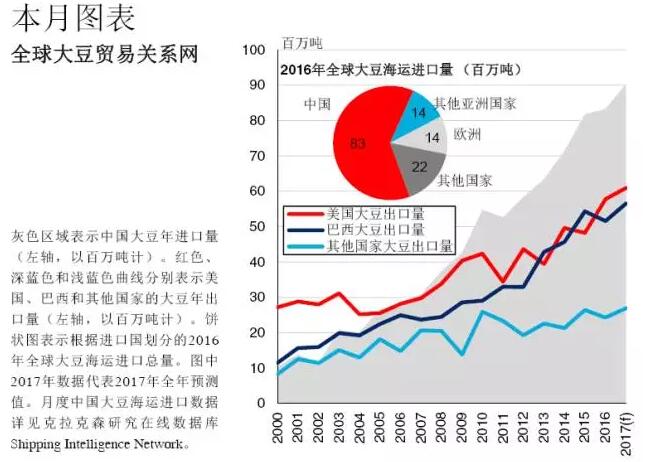Global Soybean Trade: Sino-US Pakistan’s “Triangle Love”

- Date: Aug 16, 2017
- Comments: no comments
- Categories: News
According to Clarkson Shipping, the global soybean shipping trade grew strongly between 2000 and 2016, with a CAGR of 7%, contributing 40% of the growth in global food and maritime trade. In the whole year of 2016, the global soybean trade volume totaled 134 million tons, accounting for 30% of the total global trade in grain and sea trade. In recent years, the two major characteristics of the global soybean trade sector is China’s growing demand for soybean imports and the United States and Brazil in China’s soybean import trade competition.
China’s self-sufficiency usher in import tide
In the mid-1990s, China began to look for food supplies from overseas markets as domestic food production was insufficient to meet the increase in meat consumption caused by population growth. Compared to corn and wheat, soybean cultivation has a high demand for irrigation and arable land. So the Chinese government is more preferred to import soybeans, squeezed into soybean meal and soybean oil, respectively, for the production of animal feed and food processing and cooking needs. During the period from 2000 to 2016, China’s soybean import volume increased from 10 million tonnes to 83 million tonnes, contributing 84 percent to the growth of global soybean shipping imports over the same period.
The United States to seize the initiative to stabilize export trade
In this context, the United States in the late 1930s to take immediate action to improve domestic soybean production and exports, became China’s most important soybean trading partners. In 2000, the United States exported only 5 million tons of soybeans to China, and the export volume in 2013 has reached 24 million tons, which is the same period the US soybean export volume rose from 27 million tons to 39 million tons contributed 62% share. With the help of China and the stable soybean trade relations with the United States, the United States has maintained a leading position in the global soybean export market, and its export volume of soybeans in the period from 2000 to 2013 accounted for 44% of the global soybean export volume.
Brazil is now the first to win the first export
However, China will also look to other soybean producers. Soybean from Brazil to China grew from 2 million tonnes in 2000 to 32 million tonnes in 2013. This fully reflects the price advantage of Brazilian soybean and its efficient production capacity, through the land and degraded grassland to clean up the conversion to arable land for more soybean production. As Brazilian soybeans continue to sail to China, Brazilian soybean shipping exports increased from 12 million in 2000 to 43 million tonnes in 2013, achieving nearly fourfold growth, which surpassed the United States as the world’s largest soybean in 2013 export country.
The United States and Pakistan compete for each other in the Chinese market
China’s soybean imports have continued to grow rapidly since 2013, and imports totaled about 83 million tonnes in 2016, an increase of 31% (20 million tonnes) compared to 2013. On the export side, the export competition between the United States and Brazil is still fierce, the position of the first country of soybean exports is changing hands almost every year. US soybean exports in 2017 increased by 5% to 61 million tons to ensure that it can be the first time in 2012 for two consecutive years defending first. However, Brazilian soybean exports are outdone, and their production has recovered from the destruction of El’s in 2016 and plans to increase soybean exports by 10% to 57 million tonnes in 2017. Moreover, more and more people believe that in the two major soybean exporters, Brazil has more capacity to maintain steady growth in soybean exports over the next few years because Brazil has more extra water and arable land to grow soybeans The
In this way, China’s growing demand for soybeans and the export competition that the United States and Brazil are still staged have become the key to global trade in soybeans this century. And the three countries between the turbulent and fruitful “triangular love” will continue to promote the next few years the global soybean trade growth.








No Comments Yet.